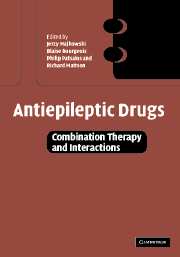Book contents
- Frontmatter
- Contents
- List of contributors
- Foreword
- Foreword
- Acknowledgements
- Part I Introduction
- 1 Combination therapy of diseases: general concepts
- 2 Combination therapy with antiepileptic drugs: potential advantages and problems
- 3 Pharmacogenetic aspects
- Part II Pharmacokinetic interactions
- Part III Pharmacodynamic interactions
- Part IV Drug interactions in specific patient populations and special conditions
- Part V Conclusions and future perspectives
- Index
3 - Pharmacogenetic aspects
from Part I - Introduction
Published online by Cambridge University Press: 07 September 2009
- Frontmatter
- Contents
- List of contributors
- Foreword
- Foreword
- Acknowledgements
- Part I Introduction
- 1 Combination therapy of diseases: general concepts
- 2 Combination therapy with antiepileptic drugs: potential advantages and problems
- 3 Pharmacogenetic aspects
- Part II Pharmacokinetic interactions
- Part III Pharmacodynamic interactions
- Part IV Drug interactions in specific patient populations and special conditions
- Part V Conclusions and future perspectives
- Index
Summary
Introduction
Pharmacogenetics and pharmacogenomics are fields which show how the genetic make-up of an individual can influence drugs effects. In epilepsy it is one part of a number of influences that determine drug responsiveness. Other contributors are age, sex, concomitant medication, other illnesses and cause and type of epilepsy. The cause and type of epilepsy may have a complex interaction with the genetics of drug response, as the genes that contribute to epilepsy can directly affect drug responsiveness (see below), and epilepsy itself may influence genetic expression. The observation that inherited differences can affect drug disposition, adverse effects and responsiveness is not new. The observation that there are slow metabolizers of phenytoin was made in the 1960s (Kutt et al., 1964), and later this was noted to be an inherited familial trait (Vasko et al., 1980; Vermeij et al., 1988).
The human genome project will undoubtedly revolutionize the practice of medicine. The relatively small number of human genes (approximately 30,000–40,000; International Human Genome Sequencing Consortium, 2001) and the growth of rapid sequencing technology has brought the possibility of complete genome screening closer to reality. Variation in these genes, environmental factors, and their joint interactions determine our individual response to drugs. Human genetic variation mostly consists of single nucleotide polymorphisms (SNPs) and small insertion or deletion (INDELS) polymorphisms. Over 1.4 million SNPs were identified in the initial sequencing of the human genome (International SNP Map Working Group, 2001).
Keywords
- Type
- Chapter
- Information
- Antiepileptic DrugsCombination Therapy and Interactions, pp. 26 - 44Publisher: Cambridge University PressPrint publication year: 2005



